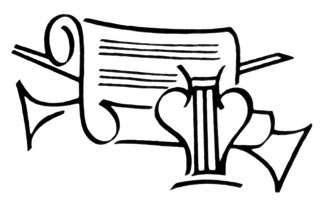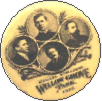Form in Music
A Primer by Richard Karschner
There are two different KINDS of music.
- Program Music - music that describes a story, scene or mood.
- Absolute Music - music for music sake - with no program
Program Music - each of the primary periods of music have produced some famous descriptive works:
- Baroque: “The Four Seasons” - Antonio Vivaldi
- Classical: “Pastoral Symphony” - Beethoven
- Romantic: “The Sorcerer’s Apprentice” - Dukas (one of many)
- Contemporary: “Billy the Kid” – Copland (among others)
Absolute Music: - Music which follows more of a format or formula rather than a story, scene or mood.

Within the realm of Program Music there are typical subjects in addition to the kind listed above:
Nationalism - a composer writing about his own country. Here are only a few examples:
- 1812 Overture : Tchaikovsky – describes the Russian Victory over Napoleon using music from France and Russia.
- Pictures at an Exhibition : Musorgsky – A musical impression of various artwork, one of the most famous – The Great Gate of Kiev.
- Peer Gynt Suite : Edvard Grieg – Description of one of hero of the Norwegian legend – In the Hall of the Mountain King is a familiar work.
- The Moldeau : Bedrich Smetana - portrayal of a trip down the famous river of Czechoslovakia, describing the scenes and activities along the way.
- The Ring of the Nibelung : Richard Wagner – cycle of four operas, centered around the Rhine River about the mythological founders of Germany.
- Decoration Day : Charles Ives – portrays two bands starting at opposite ends of the town, marching toward each other playing different songs.
- Ballet Music by Aaron Copland and Leonard Bernstein would fit into this category.
Exoticism – sounds about the same as nationalistic music, but written by a composer who uses his imagination to write about the subject of a far away place or country.
- Carmen : George Bizet - French opera about a factory worker and bullfighter from Spain.
- Scherazade : Rimsky-Korsakov - the Russian composer evokes the picturesque atmosphere of the Arabian Nights.
- Aida : Geusseppi Verdi – Italian opera staged in Egypt about a soldier and his conquered slave.
- Madame Butterfly : Giacomo Puccini - Italian opera about Japanese girl waiting for return of her American Sailor.

FORM IN MUSIC
Most of the instrumental music performed in the early years at Willow Grove Park fits into certain traditional forms.
Sonata – Allegro Form.
This was the standard form used during the classical period (1600-1750) by figures like Haydn, Mozart and Beethoven. It is similar to a battle between two different keys, tonal or pitch centers. To assist the younger reader, this form is (overly) simplified into the following example.
Our example will use Twinkle, Twinkle Little Star (in the key of C) and Mary Had a Little Lamb (in the key of G), a fifth higher.
- Exposition:
Theme 1 (Twinkle)(is stated in the Tonic key – I (C))
Theme 2 (Mary)(is stated in the Dominant key – V(G))
- Development:
This is section which best shows the skill of the composer. It often starts in the Dominant V key (G) and will travel through a variety of keys bringing the listener back to the Tonic key (I) (C). Often a small portion of the themes ( “how I wonder and/or little lamb, little lamb”) are used as thematic material to negotiate this storm-like section. The section ends with the tonic key (I) (C) having won the battle of the key or tonality.
- Recapitulation: (restating of the themes)
Theme 1 (Twinkle) (is restated in the original, Tonic key – I (C))
Theme 2 (Mary) (having lost the battle over key is restated in the same key as theme 1 (C)).
- Coda:
Designed to let the listener know which key has won, and in which key the movement will end, familiar themes (1 or 2) or perhaps a completely new theme can be used finish solidly in the tonic (I) key (of C).
Analysis: An understanding and appreciation of the key relationship is important to the appreciation of this form. This calls for more of a sophisticated listener than American audiences provided. While important in music history, symphonies were not often programmed at Willow Grove.
Return to Learn More
|



